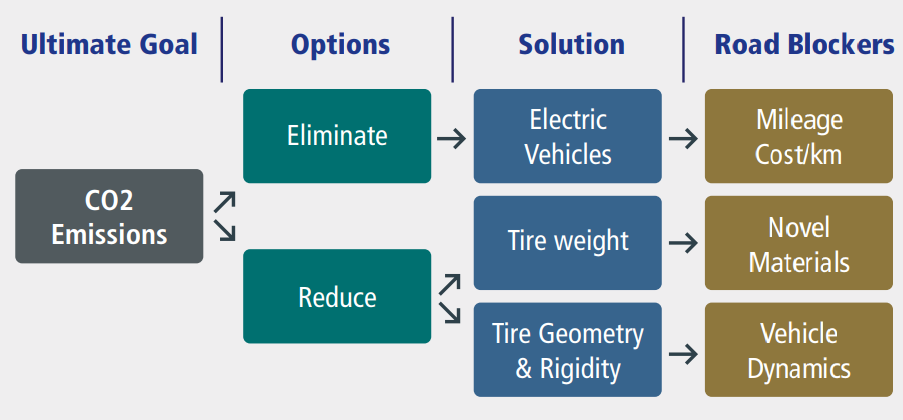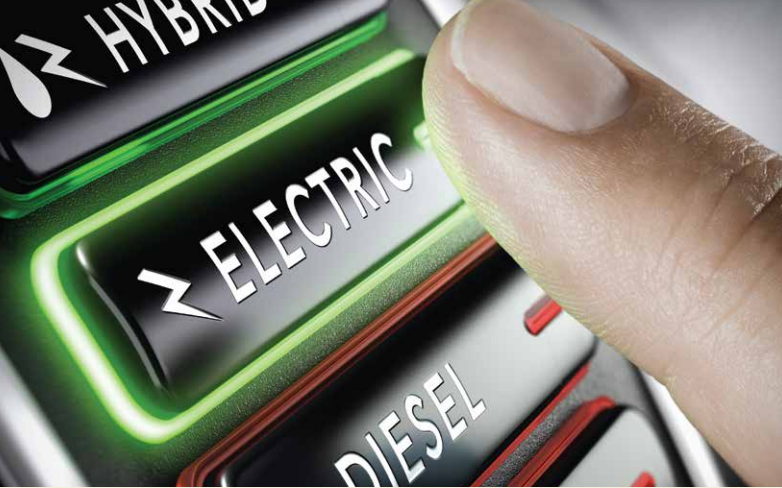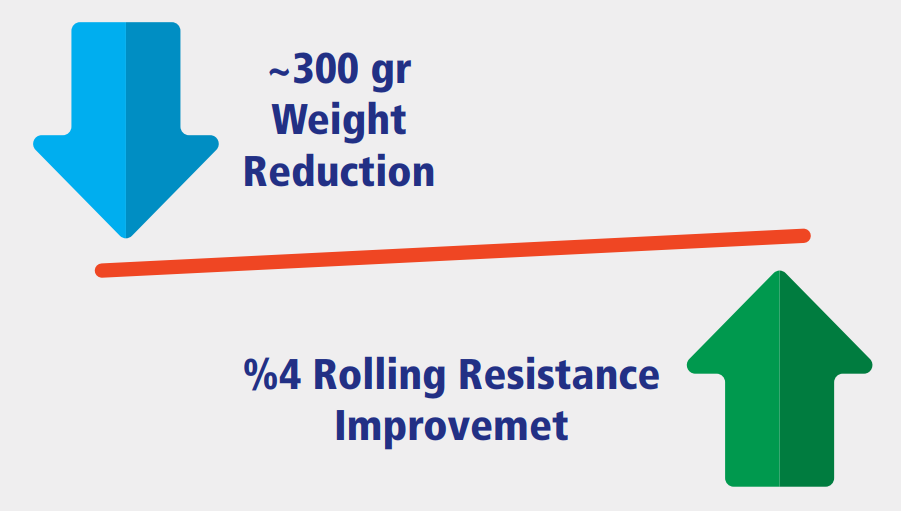Future Focus on Rolling Resistance
02 January 2018
Burak İlgün
Tags : automobile,
capmax,
capply,
co2,
Co2emission,
cord,
development,
electric,
energysave,
global warming,
hybrid,
kordsa,
reinforcer,
resistance,
rolling ,
technology,
the reinforcer,
tire
There have been many studies carried out with the aim of finding a solution to reducing rolling resistance, but only a few have related to the main reason why rolling resistance is important. It is time to remind ourselves how the Rolling Resistance story began and how far it has gone from a CO2 emissions perspective through medium- and long-term scenarios.
A global perspective on tire reinforcement will help us to understand future challenges. It is obvious that both the heart of the problem and possible solutions to it are compound related. At first, it looks like reinforcement materials do not have as much of an impact on reducing rolling resistance as compounds do. However, when compounds and reinforcement materials are considered together, then reinforcement materials are an important factor. This is because thinner tire reinforcement cords mean less compound is used.
Another novel solution is the elimination of compounds and the application of tire reinforcements without compounds. Kordsa continuously strives towards either the reduction or the elimination of compounds in tire production to reduce rolling resistance.
Background
The main driver of the automotive industry is obviously CO2 emissions. The EU target of reducing CO2 emissions to 95gr/km by 2020 challenges both the OEM and tire makers. Even though today's average fleet emissions levels are not promising in the direction of 2020, EU authorities have discussed reducing emissions down to 7ogr/km by 2025.
Today, it seems that there are two options to reach the EU targets: one is to try to totally eliminate CO2 emissions and another is making efforts to reduce them; both of these options require different problems to be solved. Table 1 shows the two options and a road map towards reaching the target. We need to analyze these two options together with their solutions and the handicaps that we still have to work on.

Table 1: There are different options and solutions to reach the EU target of reducing CO2 emissions.
The elimination of CO2 emissions through electrification: an obvious choice for the long term
As regulations are becoming stricter than ever, the options that can solve the emissions puzzle are becoming more limited. Although the total elimination of CO2 emissions is a highly desired outcome, it seems that the only solution that would lead to total elimination is the use of electrical vehicles (EVs). EVs are not a new subject in the automotive industry, and moreover many improvements have already been made by the industry. For example, the current total mileage level is better than 5 years ago and battery packs are 65 percent cheaper. Nevertheless, EVs still have low penetration within the automotive industry: less than 1 percent in some markets.
It is obvious that any new technology introduced into the automotive industry will take many decades to become accepted. Looking to history, we see that automatic transmission, the airbag, navigation systems and hybrid vehicles have had a deployment cycle between 15 and 50 years. Therefore, a long deployment cycle is also expected for EVs. However, there is one very major driving force that will accelerate the deployment of EVs: mandatory regulations. As soon as CO2 emissions authorities dictate newer and higher standards, car manufacturers will need to put more effort into building EV cars.
Some analysis suggests that if regulations mandate emissions levels of 7ogr/km CO2 by 2025, switching to electrical engines instead of investing in conventional engines will become a significantly more economic option. Recently, many major OEMs have either announced that they are investing in EVs, or have declared that they will not invest any more into internal combustion engines. A recent analysis by KMPG looking at surveys with auto industry executives the past 5 years rightly confirms that there is an inevitable trend towards EVs.
In future, while the automobile industry will be devoting more effort to the development of EVs, mainly triggered by CO2 regulations, eventually the all-time star of tire industry research will regain the spotlight: "rolling resistance". Although shared mobility is believed to reduce the total cost of mileage in Evs, it is obvious that in order to increase mileage, energy losses should be avoided. Therefore, improved rolling resistance will improve mileage for EVs, which is vitally important. Today's efforts in reducing rolling resistance will carry the tire industry to the next level.
The reduction of CO2 emissions through tire solutions: an eternal challenge
Tires are said to be the low-hanging fruits of the industry in terms of improving fuel efficiency and reducing emissions compared to the development requirements for improvements in other components. Tire industry has been dealing with rolling resistance for a few decades with all the parties in the supply chain pitching in. Rolling resistance was the "compromise" factor compared to other essential factors such as wet grip, mileage, etc. in tire production. Throughout the years, these efforts have resulted in improved products, from raw materials to tire design.

There are OEM test results that declare an enormous leap-15 percent improvement—in rolling resistance with acceptable tire performance when they test tall and narrow tires. Although this is a very important reduction in rolling resistance level, the vehicle dynamics will be much affected. Vehicle design will be essential in avoiding the side effects of tall and narrow tires, slowing penetration of the development.
Although the efforts being put in are considerable, it is not that easy to reduce the average CO2 emissions of an OEM's fleet. It is expected that most of the OEMs will not match the legal emission levels for 2020. This indicates that OEMs will be looking for emerging solutions to decrease their fleets' average CO2 emissions. As discussed above, OEMs will stop choosing to invest in conventional engines. So, to improve the rolling resistance of internal combustion engine cars, tire technology will again take the lead to achieve these targets economically.
A reduction in tire weight will directly or indirectly prevent losses due to hysteresis. The hysteresis of the rubber compound is the controlling factor for rolling resistance, and therefore the reduction of the amount of rubber compound is essential. The most effective area to reduce it is the tread of the tire and most of the focus has been given to this factor over the years. Apart from the tread, rubber compound is also applied to cover reinforcement materials in the tire. The carcass, cap ply, steel belts, and bead are the components that are rubberized.
It is possible to decrease the amount of compound used by higher modulus NY66 cords in cap ply or higher tenacity PET cords in the carcass. Advanced NY66 cord designs that enable UHP performance are produced by the twisting of heavy dtex single yarns. This advanced cord design results in 20 percent less cord gauge and a 35 percent higher modulus level that enables compound saving compared to regular NY66 1400/2 cord constructions.
The elimination of compound from reinforcement is possible with ready to use cap ply materials available in the industry such as Capmax by Kordsa. Due to the cap ply application type, an up to circa 30ogr/tire weight reduction is possible. Since there is no compound to create hysteresis, a positive effect is observed in terms of a circa 4 percent reduction in rolling resistance. In outdoor test results, tires with Capmax performing equally as well as tires with conventional rubberized cap ply.
New reinforcement materials will play a leading role in shaping the future of the tire industry, both in the medium term and long term.

Table 2: The relationship between weight reduction and rolling resistance improvement when using Capmax by Kordsa.
Tags : automobile,
capmax,
capply,
co2,
Co2emission,
cord,
development,
electric,
energysave,
global warming,
hybrid,
kordsa,
reinforcer,
resistance,
rolling ,
technology,
the reinforcer,
tire